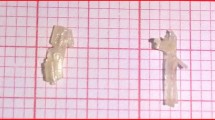Abstract
Thermodynamic characteristics of electrophilic substitution reactions in 1-methyltetrazole and 1H-tetrazole via the elimination–addition scheme (HO– anion and hydroxonium ion as model agents) were compared by analysis of the quantum chemical calculation results performed using the DFT/B3LYP/6-31G(d,p) method taking into account specific solvation effects. The possibility for both reactions to occur without the preceding formation of N-protonated azolium salts was shown. This possibility has earlier been demonstrated for 1H-tetrazole using the DFT/B3LYP/6-31G(d,p) and DFT/B3LYP/6-31G(2df,p) methods taking into account the solvation effects in an aqueous solution in terms of polarized continuum model when proton was chosen as a model electrophile.
Similar content being viewed by others
References
N. D. Chuvylkin, A. N. Subbotin, L. I. Belen’kii, Russ. Chem. Bull. (Int. Ed.), 2016, 65, 939 [Izv. Akad. Nauk, Ser. Khim., 2016, 939].
V. P. Ananikov, E. A. Khokhlova, M. P. Egorov, A. M. Sakharov, S. G. Zlotin, A. V. Kucherov, L. M. Kustov, M. L. Gening, N. E. Nifantiev, Mendeleev Commun., 2015, 75.
L. I. Belen’kii, Chem. Heterocycl. Compd. (Eng. Transl.), 1986, 22, 587 [Khim. Geterotsikl. Soedin., 1986, 749].
P. N. Gaponik, O. A. Ivashkevich, in Chemical Problems of the Development of Novel Materials and Technologies, Minsk, 2003, p. 193.
L. I. Belen’kii, A. N. Subbotin, N. D. Chuvylkin, Russ. Chem. Bull. (Int. Ed.), 2015, 64, 2050 [Izv. Akad. Nauk, Ser. Khim., 2015, 2050].
L. I. Belen’kii, A. N. Subbotin, N. D. Chuvylkin, Russ. Chem. Bull. (Int. Ed.), 2015, 64, 2610 [Izv. Akad. Nauk, Ser. Khim., 2015, 2610].
R. E. Trifonov, V. A. Ostrovskii, Russ. J. Org. Chem. (Engl. Transl.), 2006, 42, 1585 [Zh. Org. Khim., 2006, 42, 1599].
S. V. Voitekhovich, O. A. Ivashkevich, P. N. Gaponik, Russ. J. Org. Chem. (Engl. Transl.), 2013, 49, 635 [Zh. Org. Khim., 2013, 49, 655].
G. da Silva, E. E. Moore, J. W. Bozzelli, J. Phys. Chem. A, 2006, 110, 13979.
V. E. Matulis, Yu. S. Halauko, O. A. Ivashkevich, P. N. Gaponik, THEOCHEM, 2009, 909, 19.
Yu. S. Halauko, V. E. Matulis, O. A. Ivashkevich, Yu. V. Grigoriev, P. N. Gaponik, Tetrahedron, 2010, 66, 3415.
N. D. Chuvylkin, I. D. Nesterov, L. I. Belen’kii, Russ. Chem. Bull. (Int. Ed.), 2007, 56, 1425 [Izv. Akad. Nauk, Ser. Khim., 2007, 1425].
F. M. Stoyanovich, in Novye napravleniya khimii tiofena [Novel Trends in Thiophene Chemistry], Ed. Ya. L. Gol’dfarb, Nauka, Moscow, 1976, p. 96 (in Russian).
H. W. Gchwend, H. R. Rodriguez, Org. Reactions, 1979, 26, 1.
J. Tomasi, B. Mennucci, R. Cammi, Chem. Rev., 2005, 105, 2999.
M. J. Frisch, G. W. Trucks, H. B. Schlegel, G. E. Scuseria, M. A. Robb, J. R. Cheeseman, G. Scalmani, V. Barone, B. Mennucci, G. A. Petersson, H. Nakatsuji, M. Caricato, X. Li, H. P. Hratchian, A. F. Izmaylov, J. Bloino, G. Zheng, J. L. Sonnenberg, M. Hada, M. Ehara, K. Toyota, R. Fukuda, J. Hasegawa, M. Ishida, T. Nakajima, Y. Honda, O. Kitao, H. Nakai, T. Vreven, J. A. Montgomery, J. E. Peralta, F. Ogliaro, M. Bearpark, J. J. Heyd, E. Brothers, K. N. Kudin, V. N. Staroverov, T. Keith, R. Kobayashi, J. Normand, K. Raghavachari, A. Rendell, J. C. Burant, S. S. Iyengar, J. Tomasi, M. Cossi, N. Rega, J. M. Millam, M. Klene, J. E. Knox, J. B. Cross, V. Bakken, C. Adamo, J. Jaramillo, R. Gomperts, R. E. Stratmann, O. Yazyev, A. J. Austin, R. Cammi, C. Pomelli, J. W. Ochterski, R. L. Martin, K. Morokuma, V. G. Zakrzewski, G. A. Voth, P. Salvador, J. J. Dannenberg, S. Dapprich, A. D. Daniels, Ö. Farkas, J. B. Foresman, J. V. Ortiz, J. Cioslowski, D. J. Fox, Gaussian 09, Revision D.01, Gaussian, Inc., Wallingford CT, 2013.
P. N. Gaponik, O. A. Ivashkevich, in Vybranyya navukovyya pratsy Belaruskaga dzyarzhanaga universiteta u syami tamakh [Selected Scientific Works of the Belarus State University (in seven volumes)], Vol. V, Khimiya, Minsk, BDU, 2001, p. 353 (in Belorussian).
Author information
Authors and Affiliations
Corresponding author
Additional information
For Part 6, see Ref. 1.
Based on the materials of the International Congress on the Heterocyclic Chemistry “KOST-2015” (October 18–23, 2015, Moscow, Russia).
Published in Russian in Izvestiya Akademii Nauk. Seriya Khimicheskaya, No. 7, pp. 1716–1721, July, 2016.
Rights and permissions
About this article
Cite this article
Chuvylkin, N.D., Subbotin, A.N. & Belen’kii, L.I. Quantum chemical studies of azoles 7. N-alkyl substituent effect on calculated thermodynamic parameters of the electrophilic substitution mechanism in 1H-tetrazole via elimination–addition scheme without preceding formation of N-protonated azolium salts. Russ Chem Bull 65, 1716–1721 (2016). https://doi.org/10.1007/s11172-016-1500-2
Received:
Published:
Issue Date:
DOI: https://doi.org/10.1007/s11172-016-1500-2




